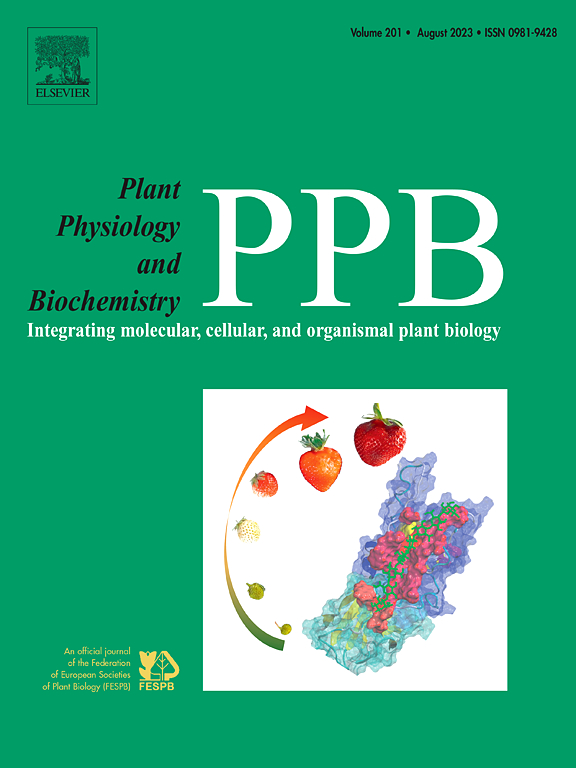外源褪黑素通过激素信号通路影响猕猴桃的生长和品质
IF 5.7
2区 生物学
Q1 PLANT SCIENCES
引用次数: 0
摘要
猕猴桃因其丰富的营养成分而受到消费者的欢迎。褪黑素是一种新发现的植物激素,对果实生长的影响尚未完全了解。本研究以金燕猕猴桃为研究对象,在果实膨大期施用不同浓度的褪黑素。结果表明,褪黑素处理显著提高了单果的纵、横径和单果重,尤其是在褪黑素浓度为200 μM时;此外,褪黑素处理增加了可溶性糖浓度和糖与酸的比例,同时降低了可滴定酸的含量。转录组分析表明,deg主要富集与植物激素和淀粉糖代谢相关的通路。淀粉降解基因AcBAMs和蔗糖合成相关基因AcSPSs和AcSUS4表达上调,淀粉含量降低,蔗糖、果糖和葡萄糖含量升高。在200 μM褪黑激素处理下,生长素、细胞分裂素和赤霉素信号转导通路相关基因也上调,导致6-苄基氨基嘌呤(6BA)、玉米蛋白(ZT)和赤霉素3 (GA3)含量增加。通过加权共表达网络分析,确定了4个结构基因和2个转录因子参与褪黑素介导的果实发育和淀粉-蔗糖代谢的潜在关键调控因子。本文章由计算机程序翻译,如有差异,请以英文原文为准。
Exogenous melatonin affects kiwifruit growth and quality through hormone signaling pathway
Kiwifruit is popular among consumers owing to its rich nutritional content. Melatonin, a newly recognized plant hormone, has yet to be fully understood in terms of its impact on fruit growth. In this study, we applied different concentrations melatonin to ‘Jinyan’ kiwifruit at fruit expansion phase. The results showed that melatonin treatments significantly increased the vertical and horizontal diameter and single fruit weight, especially at 200 μM melatonin. Additionally, melatonin treatment increased the soluble sugar concentration and the ratio of sugar and acid, while reducing titrable acid content. Transcriptome analysis showed that DEGs were mainly enriched pathways related to plant hormone and starch sucrose metabolism. The expression of starch degradation genes AcBAMs and sucrose synthesis related genes AcSPSs and AcSUS4 were up-regulated, accompanied by decreased starch content and increased the contents of sucrose, fructose and glucose. Genes involved in auxin, cytokinin and gibberellin signal transduction pathway were also up-regulated at 200 μM melatonin treatment, resulting in increased the contents of 6BA (6-Benzyl aminopurine),ZT (Zeatin) and GA3 (Gibberellin 3). Through weighted co-expression network analysis, four structural genes and two transcription factors were identified as potential key regulators involved in melatonin-mediated regulation on fruit development and starch-sucrose metabolism.
求助全文
通过发布文献求助,成功后即可免费获取论文全文。
去求助
来源期刊
CiteScore
11.10
自引率
3.10%
发文量
410
审稿时长
33 days
期刊介绍:
Plant Physiology and Biochemistry publishes original theoretical, experimental and technical contributions in the various fields of plant physiology (biochemistry, physiology, structure, genetics, plant-microbe interactions, etc.) at diverse levels of integration (molecular, subcellular, cellular, organ, whole plant, environmental). Opinions expressed in the journal are the sole responsibility of the authors and publication does not imply the editors'' agreement.
Manuscripts describing molecular-genetic and/or gene expression data that are not integrated with biochemical analysis and/or actual measurements of plant physiological processes are not suitable for PPB. Also "Omics" studies (transcriptomics, proteomics, metabolomics, etc.) reporting descriptive analysis without an element of functional validation assays, will not be considered. Similarly, applied agronomic or phytochemical studies that generate no new, fundamental insights in plant physiological and/or biochemical processes are not suitable for publication in PPB.
Plant Physiology and Biochemistry publishes several types of articles: Reviews, Papers and Short Papers. Articles for Reviews are either invited by the editor or proposed by the authors for the editor''s prior agreement. Reviews should not exceed 40 typewritten pages and Short Papers no more than approximately 8 typewritten pages. The fundamental character of Plant Physiology and Biochemistry remains that of a journal for original results.

 求助内容:
求助内容: 应助结果提醒方式:
应助结果提醒方式:


